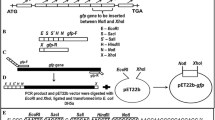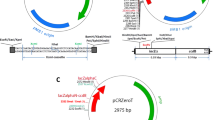Abstract
PCR product cloning is the foundational technology for almost all fields in the life sciences. Numerous innovative methods have been designed during the past few decades. Enzyme-free cloning is the only one that avoids post-amplification enzymatic treatments, making the technique reliable and cost effective. However, the complementary staggered overhangs used in enzyme-free cloning tend to result in self-ligation of the vector under some circumstances. Here, we describe a “T-type” enzyme-free cloning method: instead of designing the complementary staggered overhangs used in conventional enzyme-free cloning, we create “T-type” overhangs that reduce the possibility of self-ligation and are more convenient for multi-vector cloning. In this study, we systematically optimize “T-type” enzyme-free cloning, compare its cloning background with that in conventional enzyme-free cloning, and demonstrate a promising application of this technique in multi-vector cloning. Our method simplifies post-amplification procedures and greatly reduces cost, offering a competitive option for PCR product cloning.





Similar content being viewed by others
References
Smith, H. O., & Wilcox, K. W. (1970). A restriction enzyme from Hemophilus influenzae. I. Purification and general properties. Journal of Molecular Biology, 51(2), 379–391.
Danna, K., & Nathans, D. (1971). Specific cleavage of simian virus 40 DNA by restriction endonuclease of Hemophilus influenzae. Proceedings of the National academy of Sciences of the United States of America, 68(12), 2913–2917.
Cohen, S. N., Chang, A. C., Boyer, H. W., & Helling, R. B. (1973). Construction of biologically functional bacterial plasmids in vitro. Proceedings of the National academy of Sciences of the United States of America, 70(11), 3240–3244.
Aslanidis, C., & de Jong, P. J. (1990). Ligation-independent cloning of PCR products (LIC-PCR). Nucleic Acids Research, 18(20), 6069–6074.
Haun, R. S., Serventi, I. M., & Moss, J. (1992). Rapid, reliable ligation-independent cloning of PCR products using modified plasmid vectors. BioTechniques, 13(4), 515–518.
Aslanidis, C., de Jong, P. J., & Schmitz, G. (1994). Minimal length requirement of the single-stranded tails for ligation-independent cloning (LIC) of PCR products. PCR Methods and Applications, 4(3), 172–177.
Li, M. Z., & Elledge, S. J. (2007). Harnessing homologous recombination in vitro to generate recombinant DNA via SLIC. Nature Methods, 4(3), 251–256.
van den Ent, F., & Lowe, J. (2006). RF cloning: A restriction-free method for inserting target genes into plasmids. Journal of Biochemical and Biophysical Methods, 67(1), 67–74.
Unger, T., Jacobovitch, Y., Dantes, A., Bernheim, R., & Peleg, Y. (2010). Applications of the restriction free (RF) cloning procedure for molecular manipulations and protein expression. Journal of Structural Biology, 172(1), 34–44.
Quan, J., & Tian, J. (2009). Circular polymerase extension cloning of complex gene libraries and pathways. PLoS ONE, 4(7), e6441.
Tillett, D., & Neilan, B. A. (1999). Enzyme-free cloning: A rapid method to clone PCR products independent of vector restriction enzyme sites. Nucleic Acids Research, 27(19), e26.
Matsumoto, A., & Itoh, T. Q. (2011). Self-assembly cloning: A rapid construction method for recombinant molecules from multiple fragments. BioTechniques, 51(1), 55–56.
Liu, Z. (1996). Hetero-stagger cloning: Efficient and rapid cloning of PCR products. Nucleic Acids Research, 24(12), 2458–2459.
Murugan, R. (2002). Revised theory on DNA renaturation kinetics and its experimental verification. Biochemical and Biophysical Research Communications, 293(2), 870–873.
Acknowledgments
The authors thank Dr. Zhongdao Li, Shiqiang Lin, Liwei Wang, and Jinjun Wu for their comments and suggestions; Dr. J.E. Fleming for careful proofreading and revision of the manuscript. The authors thank Dr. Mingzhang Yang and Shanghua Fan for providing some of the experimental materials. This study was financially supported by the National Natural Science Foundation of China (Grant No: 31170132), National Basic Research Program of China (Grant No.: 2012CB518700).
Conflict of interests
None.
Author information
Authors and Affiliations
Corresponding authors
Electronic supplementary material
Below is the link to the electronic supplementary material.
Rights and permissions
About this article
Cite this article
Yang, RB., Bi, LJ. & Zhang, XE. A Novel T-type Overhangs Improve the Enzyme-Free Cloning of PCR Products. Mol Biotechnol 55, 10–16 (2013). https://doi.org/10.1007/s12033-012-9597-5
Published:
Issue Date:
DOI: https://doi.org/10.1007/s12033-012-9597-5




